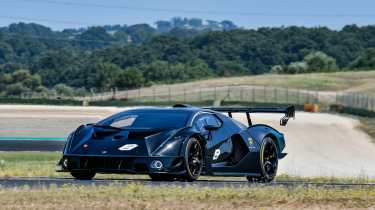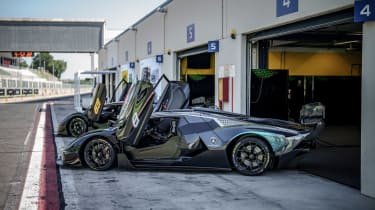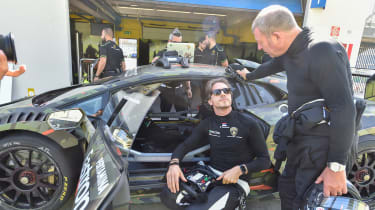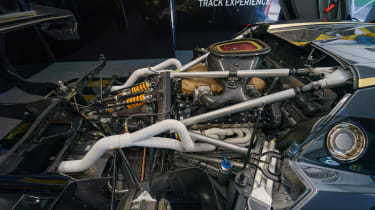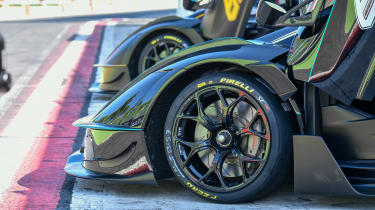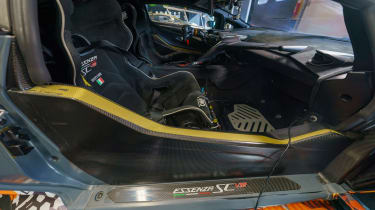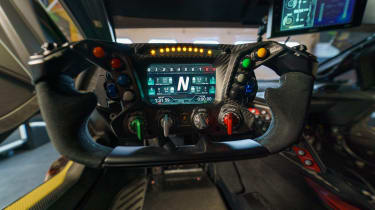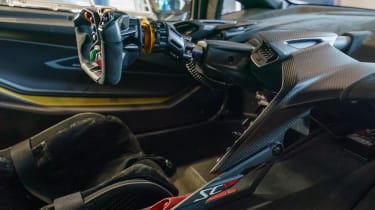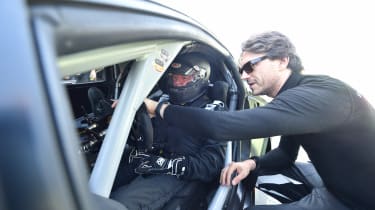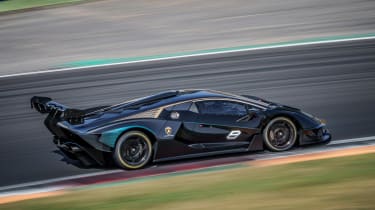Lamborghini Essenza SCV12 2021 review – a no holds barred expression of pure Lamborghini
Lamborghini’s answer to Ferrari’s XX programme is, on this evidence, every bit as desirable and dramatic. More so, if anything.
Lamborghini started on the Essenza project three years ago now. Think of it as Sant'Agata’s answer to Ferrari’s XX programme, whereby the factory designs and develops the craziest, most expensive hypercars imaginable, then sells them to their wealthiest customers they know – the ones who crave the ultimate exclusive experience on four wheels but don’t necessarily want to go racing to achieve it. Although it turns out that quite a few of them do actually race as well. For some folks, it seems, the edge is never quite close enough.
Anyway, while Ferrari might have pioneered this concept some 16 years ago with the FXX, Lamborghini is now unashamedly replicating the idea and has enlisted the services of one Emanuele Pirro – five times Le Mans winner with Audi Sport and all-round racing car legend – to help them do it. Pirro is effectively the boss of the Essenza program, with the dramatic new €2.2 million, 819bhp SCV12 being the first of a whole new line in ultra-fast versions of already brisk hypercars from Lamborghini that will be limited in numbers (to just 40 in this case) and run by the factory, just like the Ferrari XX cars are.
If an Essenza owner wants to take their car home and just ogle it, or even run a spanner over it every now and again, they can. But like Ferrari, Lamborghini strongly encourages owners to let the factory keep the cars and deliver them to whatever tracks an owner wishes to drive on, providing full technical and even high-end hospitality support if they wish.
More reviews
Group tests
- Lotus Emira Turbo SE v Alpine A110 GTS – two of the last surviving mid-engined sports cars
- Alpine A290 v Alpine A110 – how much DNA do they really share?
- Ariel Atom 4R v Caterham Seven ‘evo25’: power-to-weight heroes go head-to-head
- Ariel Atom 4 v Caterham Seven 310R v Lotus Elise Cup 250
- £200,000 supercar shoot-out: AMG v Aston Martin v Maserati v McLaren
- Audi Quattro, RS2 and RS3: five-cylinder icons head-to-head
- Who makes the best GT car? Aston Martin v Bentley v Maserati
- Caterham Super Seven 600 v Super Seven 2000
- Corvette Stingray v Porsche Cayman GTS v Audi R8 RWD
- Great Ferrari hypercars driven: 288 GTO, F40, F50 and Enzo head-to-head
In-depth reviews
- Abarth 600e 2025 review – Italy gives the Alpine A290 something to worry about
- Alpine A110 review – the sports car Lotus should be building
- Aston Martin Vantage 2025 review – a thrilling Mercedes-AMG GT and 911 Turbo S alternative
- Audi R8 (2015 - 2024) review – the ultimate soft-focus supercar
- Bentley Flying Spur review – the ultimate driver’s limousine
Long term tests
- Abarth 695C Turismo Fast Fleet test – living with the charming Italian hatch
- Alfa Romeo Giulia Veloce long term test – can Italy beat Germany?
- Alpina B10: Alpina B10: end of term report
- Aston Martin Vantage (2006) Fast Fleet test – living with a £30k V8 Aston
- Caterham Seven evo25 Fast Fleet test – living with a track car for the road
- Caterham Seven evo Edition revealed – bespoke 420R joins the Fast Fleet
- Cupra Leon 300 Fast Fleet test – living with Spain's 300bhp hot hatch
- Cupra Ateca VZN Fast Fleet test – four months with Cupra's hot crossover
- Cupra Leon Estate 310 4Drive Fast Fleet test – living with the 306bhp hot estate
- Ford Mustang GT
Review
- New Bentley Batur 2023 review – can it possibly be worth £1.65m?
- 2023 Chevrolet Corvette C8 Z06 review – the American 911 GT3?
- BBR Supercharged Mazda MX-5 (ND) 2023 review – tuned 250bhp roadster driven
- MG4 Trophy 2023 review
Reviews
- Abarth 695 75 Anniversario edition 2024 review – a fitting send-off for Abarth’s hot supermini?
- Abarth 500e 2023 review
- AC Cobra 378 Superblower MkIV 2021 review – another V8 Cobra, but with a GM heart this time
- Acura Integra Type S 2024 review – a Honda Civic Type R with added restraint
- Alfa Romeo Giulia review – get one while you still can
- Alfa Romeo 33 Stradale 2025 review – a rare Italian jewel beyond compare
- Alfa Romeo SZ: history, review and specs of an icon
The car itself is Lamborghini’s idea but very much Pirro’s creation. To help him build it he assembled a team of core test drivers and engineers from within Lamborghini’s Squadra Corse racing department, who have worked tirelessly to turn it into the weapon it has become. They started with a brief from the very top to make the most extreme version of a Lamborghini imaginable, but not a racing car. Not one that would ever compete, at any rate.
It had to look like a Lamborghini, and of course drive like a Lamborghini, but it couldn’t just be an LMP1 racing car with a V12 engine in the back and raging bull on its nose. Three years, at least 50 week-long test sessions and most of one global pandemic later, the SCV12 is what they came up with. Quite some piece of work it is, too.
Engine, transmission, 0-60mph time
Behind the seats, but in front of the gearbox, sits the SCV12’s main attraction, a 6.5-litre atmospheric V12 engine. This produces 819bhp at 8500rpm but will rev to a deafeningly magnificent 8750rpm before the limiter intrudes. Torque is rated at 560lb ft at 7000rpm.
Pirro initially wanted to make a car in which the engine was a fully stressed part of the chassis, but couldn’t achieve this within the styling or budgetary constraints, so the V12 merely sits in a separate sub-frame at the back. The X-Trac sequential gearbox is a fully stressed member, however, and this sits behind the engine, unlike in the regular Aventador in which the gearbox is located directly behind the rear seats.
This on its own helps explain why the car is so much longer than the Aventador – the wheelbase is 2905mm compared with 2700mm in the Aventador – although the designers at Centro Stile told Pirro right from the start that they wanted to create a car with a longer tail that was more dramatic in profile (they succeeded). In turn, this also helped the aero package to become more effective, too, more on which below.
Lamborghini says it wasn’t fussed about making a car with the best 0-62mph time or the highest top speed, the aim instead was to make a very fast track car whose prime objective was to be as enjoyable as possible – and relatively easy – to drive. Even so, the rear wheel-drive SCV12 will still hit 62mph in well under 3sec – they are not specific about how much – while its top speed is well beyond 210mph, despite the huge rear wing.
Technical highlights
Where do you start? With that V12 engine, I guess, which is to be celebrated for endless reasons, not least of which is the fact that it will be the last ever Lamborghini V12 that’s entirely atmospheric. Everything that follows will be hybridised. Make of that what you will.
Internally the V12 isn’t radically different from the Aventador SVJ’s engine. It has the same firing order, the same compression ratio, same friction-reducing internal materials to help it spin more freely and develop more power than a regular Aventador’s 6.5-litre V12. But its exhaust system is entirely unsilenced, which lends it a personality that’s both bigger and louder than any street legal Aventador – this also allows it to rev a touch more freely at the top end.
Beyond this, the aero package is probably the key element that enables the SCV12 to be so quick around a track. Pirro is cagey about how much downforce the car generates outright, preferring instead to claim that it produces “good, usable, consistent downforce” rather than high spikes of the stuff that look good on paper but make a car edgy near its higher-speed limits.
Even so, he claims it has 30% more downforce than a Huracán GT3, which has at least 600kg. So it’s not going to be far away from 1000kg at 150mph if you’re in search of a headline number. It feels like it through high speed corners, too, which we’ll come to in a bit.
Another element Pirro is clearly proud of is the SCV12’s differential, which is mechanical but electronically operated in that you can alter the preload settings via a rotational button on the top left of the steering “lever” (you can’t say wheel because what you steer with is categorically not a wheel). Effectively this allows you to open or close the diff on corner entry to give a different turn in response, depending on what kind of corner you’re aiming the car at. It means you can dial in or dial out understeer/oversteer to suit whatever kind of track you’re at – or even which specific corner you’re attacking on that track.
There are five different engine modes to choose from via a rotational button on the steering, erm, control, each delivering five per cent more power. Only in mode 5 does it give you full beans. There’s also 12 stage traction control and 12 stage ABS, the first six of which are essentially wet settings, which means you still get six to play with in the dry depending on how tasty you think you are.
The dashboard is a fully digitised MOTEC item with the display in the centre of the wheel, around which all the buttons are sprinkled. Even the power steering assistance is adjustable, although Pirro’s not entirely sure why. He says to leave it where it is and just shrugs, as if to say; well some people might like it, but I’m not one of them.
Interestingly, the brakes on the car we drove were steel, although carbon ceramics are also available. Pirro says he quite likes the steel rotors because they have a wider operating temperature, they wear quite well, they don’t offer any less outright braking performance yet they cost an awful lot less than the carbon discs. The only downside is that they weigh a fair bit more, but even with steel brakes fitted the overall kerb weight of the SCV12 is just under 1500kg. “Which is too much for a pure racing car” admits Pirro “but not too bad considering how many electronic systems there are in the car and what our original intentions with it were.”
What’s it like to drive?
If you’ve ever driven an Aventador or even a Murcielago, you will get a very approximate idea of what the SCV12 is like to drive. Sort of. You can feel that same DNA in the way it responds to your inputs and feels very obviously mid-engined in its fundamental behaviour. You still feel like you are sitting at the end point of a V-shaped missile in which most of the natural inertia sits behind you, waiting to overtake you if you get it wrong.
But in reality nothing can you prepare you for the way the SCV12 dismantles the ground that passes beneath its massive Pirelli tyres. And in truth it’s far better balanced and much, much quicker than even the very fastest road-going Aventadors. The sheer acceleration it is capable of generating is genuinely shocking to begin with, yet inevitably it’s the brakes and the aerodynamic grip it produces – assuming you can bring yourself to commit it to and then hold on through a high speed corner – that leave you gasping hardest in disbelief.
It is a seriously quick car, at least three seconds quicker than a GT3 Huracán around a track like Vallelunga, where we drove it. An Aventador SVJ wouldn’t get within 15 seconds of it around this circuit, and it’s not just the fitment of a set of wide Pirelli slicks that bring the lap time. No, it’s the braking power and the chassis’ aerodynamic stability that make the SCV12 feel most like a full blown racing car, once you’ve relaxed a bit and got used to what it can do.
The brakes are heroic in the way you can stop in such a terrifyingly short distance from such enormous speeds, lap after lap, knowing that it is only your limits, not those of the car, that prevent you from braking later and harder, and therefore going faster.
Getting used to the aerodynamics to a point where you can use them properly to go faster is simply a matter of time, and trust, but you need a certain degree of confidence in what the engineers claim is possible merely to scratch the surface in this car. Otherwise you’d never go fast enough to get the air to work in your favour. But if and when you do, the rewards become a) very obvious but also b) slightly surreal.
Even in third gear corners the SCV12 just sticks when you think surely it’s about to slide. And in fourth and fifth gear sweepers it feels spookily keyed into the tarmac, to a point where you can actually sense the downward forces increasing via the steering and through the seat as the aerodynamic loads go up.
The steering is hyper accurate but not exactly bubbling with feel. Instead it’s an extremely effective way of guiding the nose of the SCV12 through corners but not a source of any great subjective ecstasy. Unlike the engine and gearbox, which seem oddly conventional compared with the aero and brakes, yet still form the heart of the car’s personality on the move. The racing sequential gearbox is fantastic, slicing up or down the ratios as smoothly but as quickly as you could wish for, although you do need to be positive with your inputs otherwise it’ll spit a half-hearted shift right back at you.
As for the V12 engine, it’s more magnificent than ever in the SCV12. It is truly a beautiful thing to use, or even just to listen to, when there’s no form of silencing for its exhaust. There is nothing else quite like it on this earth right now and when, finally, this engine goes to another place, a big piece of Lamborghini will go with it. Unfortunately. Roll on 2030…
Price and rivals
While Ferrari has its XX program and McLaren did something similar with the P1 GTR, there’s something about the Essenza SCV12 that is endearingly different somehow. This might well be because we know that the end is nigh for cars such as this. As such, it really does feel like a moment to enjoy while we still can, Ferrari and McLaren already having had their days in the sun with such projects.
Either way, the price of €2.2 million, plus local taxes for a car that Lamborghini would rather keep and run for you is largely irrelevant. At this level you don’t ask how much, instead you tell them which track you’d like your car delivered to for the day/week/month – delete where applicable – and Lamborghini will oblige. Then send you an additional invoice accordingly.
And if you had this sort of money, you’d want to put the SCV12 right up close to the top of the list.
